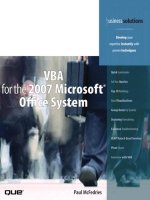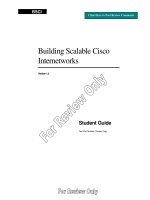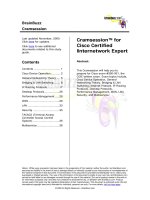Tài liệu Cramsession for Cisco Certified Internetwork Expert ppt
Bạn đang xem bản rút gọn của tài liệu. Xem và tải ngay bản đầy đủ của tài liệu tại đây (212.01 KB, 36 trang )
BrainBuzz
Cramsession
TM
Notice: While every precaution has been taken in the preparation of this material, neither the author nor BrainBuzz.com
assumes any liability in the event of loss or damage directly or indirectly caused by any inaccuracies or incompleteness of
the material contained in this document. The information in this document is provided and distributed “as-is”, without any
expressed or implied warranty. Your use of the information in this document is solely at your own risk, and Brainbuzz.com
cannot be held liable for any damages incurred through the use of this material. The use of product names in this work is
for information purposes only, and does not constitute an endorsement by, or affiliation with BrainBuzz.com. Product
names used in this work may be registered trademarks of their manufacturers. This document is protected under US and
international copyright laws and is intended for individual, personal use only. For more details, visit our legal page
.
© 2000 All Rights Reserved – BrainBuzz.com
Last updated November, 2000.
Click here
for updates.
Click here
to see additional
documents related to this study
guide.
Contents
Contents .............................. 1
Cisco Device Operation........... 2
General Networking Theory .... 5
Bridging & LAN Switching ....... 8
IP Routing Protocols..............17
Desktop Protocols.................26
Performance Management .....28
WAN ...................................29
LAN ....................................33
Security ..............................35
TACACS (Terminal Access
Controller Access Control
System) ..............................35
Multiservice .........................36
Cramsession™ for
Cisco Certified
Internetwork Expert
Abstract:
This Cramsession will help you to
prepare for Cisco exam #350-001, the
CCIE written exam. Exam topics include,
Cisco Device Operation, General
Networking Theory, Bridging & LAN
Switching, Internet Protocol, IP Routing
Protocols, Desktop Protocols,
Performance Management, WAN, LAN,
Security, and Multiservice.
BrainBuzz Cramsession: Cisco Certified Internetwork Expert
More study guides and information available at www.cramsession.brainbuzz.com
.
© 2000 All Rights Reserved – BrainBuzz.com
2
Cisco Device Operation
Router Components
ROM (Read-Only Memory) – Hosts the basic commands of the router and
sometimes a limited version of the IOS (Internet Operating System). ROM is non-
volatile, meaning it is hard-coded and does not change. Contains power-on
diagnostics, a bootstrap program, and operating system software.
RAM (Random Access Memory) – Contains the running version of the IOS and the
current running configuration. This is extremely volatile; when the router is
shutdown, anything in RAM is lost. Stores routing tables, ARP cache, fast-switching
cache, packet buffering (shared RAM), and packet hold queues.
NVRAM (Non-Volatile Random Access Memory) - As the name implies, files can
be written to this memory and will not be lost when the system is powered down.
This is where the startup version of the router configuration is stored.
Flash memory (EEPROM – Electronic Erasable Programmable Read Only
Memory) – This is where the IOS version for the router is stored. It is important
when determining what version of IOS to load on a router, that you ascertain how
much flash is installed. Different versions of IOS require more flash to be loaded.
Flash memory holds the operating system image and microcode.
Ways to Configure a New Router
• By connecting to the console port and using TFTP to download a configuration
file that has been created ahead of time.
• By connecting to the console port and running the Setup dialog.
• By connecting to the console port and directly typing in configuration
commands.
• Using bootp in conjunction with SLARP/RARP to download a configuration file
that has been created ahead of time.
Determine Hardware Configuration
The EXEC commands that will show hardware configuration of a Cisco router are
“show hardware” and “show version”
BrainBuzz Cramsession: Cisco Certified Internetwork Expert
More study guides and information available at www.cramsession.brainbuzz.com
.
© 2000 All Rights Reserved – BrainBuzz.com
3
Mode Prompts
Monitor mode rommon 1 >
User mode router>
Privileged mode router#
Global configuration mode router(config)#
Interface configuration mode router(config-if)#
Sub-interface configuration mode router(config-subif)#
Line configuration mode router(config-line)#
Router configuration mode router(config-router)#
IPX router configuration mode router(config-ipx-router)#
Really Delete Files from Flash
When you delete a file from flash, it is not removed from flash, and you will not
regain the space - it is simply marked for deletion. Once a file is marked for
deletion, issuing the “squeeze” command will perform a function similar to a hard
drive defrag and move the files on flash to reclaim the space occupied by the
“deleted” file.
Passwords
Things to know:
• The user mode password is the only one that cannot be created in the setup
dialogue.
• All passwords can be encrypted.
• A password can be set for individual lines.
• If no password is set on the vty lines there is no telnet access into this router.
• Router(config)# service password-encryption – encrypts all passwords in the
configuration file.
Procedure to Recover a Lost Password:
• Reboot the router
• Issue the break command in the first 60 seconds (CTRL-Break)
• Enter the appropriate register value (0x2142)
• Reboot the router again
• Avoid the startup script
• Copy startup to running configuration
• Change the passwords
• Copy running to startup configuration
BrainBuzz Cramsession: Cisco Certified Internetwork Expert
More study guides and information available at www.cramsession.brainbuzz.com
.
© 2000 All Rights Reserved – BrainBuzz.com
4
Types of passwords:
• Exec – used to restrict access to the EXEC mode, the basic console on the
router.
• Enable – used to restrict access to the privileged EXEC mode where changes
to the router configuration can be made.
• Enable Secret – Similar to the Enable password, but they are encrypted so
they cannot be read.
Setting different types of passwords:
• Console password – used with the routers console port.
router(config)# line con 0
router(config-line)# login
router(config-line)# password {password}
• Auxiliary password - used for the router’s auxiliary port.
router(config)# line aux 0
router(config-line)# login
router(config-line)# password {password}
• Virtual terminal password – used for telnet sessions to router.
router(config)# line vty 0 4
router(config-line)# login
router(config-line)# password {password}
• Enable password – used when enable secret is not configured or software
revision is too old.
router(config)# enable password {password}
• Enable secret password – encrypted password that provides enable privileges.
router(config)# enable secret {password}
Register Values
• 0x2102 – Default mode
• 0x2142 - The value used to recover passwords
Debug
By default, all debug information goes to the console port on a Cisco router only. To
view debug messages from a VTY session, you must issue the “terminal monitor”
command.
Router# debug serial interface - monitors keepalives on an interface.
To reduce the impact of a debug command on the CPU of the router, use the
scheduler-interval command and be sure to use the debug command as specifically
as possible.
BrainBuzz Cramsession: Cisco Certified Internetwork Expert
More study guides and information available at www.cramsession.brainbuzz.com
.
© 2000 All Rights Reserved – BrainBuzz.com
5
SNMP (Simple Network Management Protocol)
SNMP is a standard method for Network Management Stations (such as CiscoWorks)
to gather information about networked devices. This UDP-based protocol uses MIBs
(Management Information DataBases) defined for each type of device to interpret
the information provided by the SNMP enabled equipment
To enable SNMP on a router the command is "snmp-server community"
General Networking Theory
OSI Model
The OSI is a common tool for conceptualizing how network traffic is handled. In the
CCIE track, we will be interested primarily in the lower three levels. Just a reminder,
that you can use the old mnemonic “All People Seem To Need Data Processing” as a
way to help remember the sequence.
7. Application – User interface tools (such as Telnet, SMTP, FTP, etc.)
6. Presentation – Encoding/Decoding (such as ASCII, MPEG, GIF, JPEG, etc.)
5. Session – Creating, managing and terminating Presentation layer
4. Transport – Error checking and recovery, flow control and multiplexing (TCP,
SPX, etc.)
3. Network – Routing (IP, IPX, etc.)
2. Data Link (LLC/MAC)
• LLC – Manages communications
• MAC – Manages addressing and access to the physical layer
1. Physical – Establish and maintain physical connectivity
Cisco Hierarchical Internetworking Model
• Core – Concentrates all traffic traversing the network. The focus in on speed
and fast switching. Gigabit Ethernet and ATM are seen here.
• Distribution – Control layer; Aggregation of traffic, access lists, compression,
encryption and other services that provide the glue between Access and Core
layers.
• Access – The point at which users join the network. VLANs, WAN
connections, RAS services are all at this layer.
Connection-oriented vs. Connectionless Service
Connection-oriented: Similar to HDLC
• Connection establishment and termination required
• Sequenced, acknowledged data delivery
• Built-in error recovery
• Sliding window flow control
Connectionless: Data transfer without virtual circuit
BrainBuzz Cramsession: Cisco Certified Internetwork Expert
More study guides and information available at www.cramsession.brainbuzz.com
.
© 2000 All Rights Reserved – BrainBuzz.com
6
• No message sequencing
• No delivery guarantee
• Higher layer is responsible for error recovery, flow control, and reliability
Routing / Switching
• Routing is defined as a Layer-3 activity.
• Bridging is defined as a Layer-2 activity.
• Switching is defined as a Layer-2 activity. Switching is often called micro-
segmentation, in that each switched port is basically its own bridged domain.
Routing and Routed Protocols
A routing protocol, such as BGP or OSPF communicates between routers which paths
to follow in order to get data delivered to desired destinations.
A routed protocol, such as IP or IPX is the method for passing data, and travels the
paths defined by the routing protocol.
Reliability of Protocols
• TCP and LLC Type 2 are reliable protocols because they are layer four
protocols
• IP, UDP, and Frame Relay are NOT reliable protocols because they are layer
three protocols
802.x Protocols
802.2 Link Layer Control (LLC)
802.3 CSMA/CD Access Method (Ethernet)
802.4 Token Ring Bus
802.5 Token Ring
802.6 MAN (Metropolitan Area Network)
802.7 Broadband
802.8 Fiber-optic LANs
802.9 Integrated Voice & Data
802.10 LAN/MAN Security
802.11 Wireless
802.12 VGAnyLAN
BrainBuzz Cramsession: Cisco Certified Internetwork Expert
More study guides and information available at www.cramsession.brainbuzz.com
.
© 2000 All Rights Reserved – BrainBuzz.com
7
Passive Interface
When enabled on an interface this command allows the interface to hear routing
updates, but not repeat them. This helps to control routing updates.
Example: Router(config-router)# passive-interface s0
Connectivity
(Diagram A-1)
Bridged Environment (Refer to Diagram A-1)
In a bridged environment, a Cisco router will not modify the layer-2 MAC address of
a frame when bridging. In other words, a packet retains the true source and
destination MAC addresses when crossing a bridge.
For example, if in the diagram above Devices B and C were bridges, packets sent
from Host A to Host B would have the Source MAC Address of Host A’s Ethernet
adapter and the Destination MAC Address of Host B’s Ethernet adapter, regardless of
what segment they were passing through.
If a packet were to be lost anywhere between Host A and Host D, the originator
would rebroadcast.
Routed Environment (Refer to diagram A-1)
In a routed environment, when a host sends a packet it has the Source MAC Address
of either the originating host (if on the first segment) or the last router port it was
processed by. It would have the Destination MAC Address of the next hop router port
or the destination host, if on the final segment.
In other words, a host sending a packet to a router for processing to a remote
destination will have the routers local port as a destination address; a host receiving
a packet from the router will see a source address of the local router port.
BrainBuzz Cramsession: Cisco Certified Internetwork Expert
More study guides and information available at www.cramsession.brainbuzz.com
.
© 2000 All Rights Reserved – BrainBuzz.com
8
For example, if in the devices in diagram A-1 were routers:
• Packet from Host A to Host D will have source MAC address of Host A and
destination MAC address of Router B’s local Ethernet port on Segment 1.
• Packet from Host A to Host D will have source MAC address of Router B’s
Serial port and destination MAC address of Router C’s local Serial port on
Segment 2.
• Packet from Host A to Host D will have source MAC address of Router C’s
Ethernet port and a destination MAC address of Host D on Segment 3.
If a packet sent from Host A to Host D were to be lost:
• On segment 1, Host A would rebroadcast
• On segment 2, Router B would rebroadcast
• On segment 3, Router C would rebroadcast
Bridging & LAN Switching
A View of Bridging
When non-routable protocols, such as NetBEUI, LAT or SNA were developed all
devices on a network resided locally. As networks matured and bridges were
introduced to segment LANs there was the need for these devices to communicate
across networks, especially WAN links. Because these protocols did not have the
mechanisms to allow this connectivity, bridging techniques were developed to allow
the communication between devices at the Data Link Layer (layer 2 of the OSI
model).
By default, bridging is disabled on all Cisco routers. However, these services are still
an important component of the real-world networks you will be asked to deal with in
your professional life. For the purposes of the current discussion, you will also need
to know them for the CCIE certification exams, both written and lab.
Keep in mind that many non-routable protocols, most importantly SNA, are very
time sensitive, and delays can cause loss of data or session connectivity. It is also
important to understand that bridging techniques are broadcast intensive, and that
this can flood slower WAN links.
Bridging techniques
Transparent Bridging (TB)
– As the name implies, this type of bridging is
transparent to the end devices. The end devices are unaware that when they
communicate they are not local to one another. This functionality is not enabled by
default on Cisco routers, but can be turned on when needed.
When a device wishes to communicate, it will send out a broadcast to search for the
requested destination address. When a Transparent Bridge sees the first broadcast
from a device, it extracts the MAC address from the packet and enters it into its
forwarding table, the list of devices on each interface. This process of determining
what devices exist on each of the bridge’s ports is called learning.
BrainBuzz Cramsession: Cisco Certified Internetwork Expert
More study guides and information available at www.cramsession.brainbuzz.com
.
© 2000 All Rights Reserved – BrainBuzz.com
9
If the bridge receives a broadcast with a destination address that is in its forwarding
table it forwards the broadcast only to that one interface. If it is not in the table, it
repeats the broadcast out of all of its interfaces (except the one on which it was
received). This process is called flooding.
Source-Route Bridging (SRB)
– Source routing is called that because
instead of an intermediate device determining a path, the originating device creates
its own.
Routing Information Fields (RIF) are used to define paths for SRB frames to traverse
a network. They are easy to read if you understand their function. For the current
discussion it’s important that you understand how to understand how a RIF works.
Later we’ll come back to how to rip ‘um up and read ‘um.
When an SNA device needs to access a remote unit, it sends out a test frame that
attempts to find the destination. You can think of this as a broadcast in the IP
world; it isn’t, but that will help you to conceptualize.
If the destination is not found, the source device sends out a single-route or all-
routes explorer frame. Any bridges that the frame comes across in its travels add
their local bridge and ring numbers to the RIF. Eventually the frame either finds its
target or dies on the vine. IBM bridges support 8 rings and 7 bridges; IEEE 802.5
bridges support 14 bridges and 13 rings.
Once one of the explorer frames finds the destination, it returns to its creator to
announce its success. If multiple frames return, the source device takes the route of
the first frame to return, assuming this is the best path. Think of it as a race in a
maze; the first one to grab the cheese and get home first, wins.
Ripping up a RIF
This will seem complicated, but once you understand how RIFs are defined, simple
practice will drive home the necessary techniques
The first bit of the first byte of the source address is the Routing Information
Indicator (RII), which is exactly what it sounds like; it indicates that what follows is a
RIF. If this bit is a 1, the frame is a RIF; if the bit is a 0, it is not.
Here are the component parts of the first 2 bytes of a RIF, called the RCF (Routing
Control Field):
1. The first 3 bits define what kind of RIF is being examined:
• 0xx – single route frame
• 10x – all-routes explorer frame
• 11x – spanning explorer frame
2. The next 5 bits show the length of the RIF. This indicates how many bytes of
bridge/ring numbers follow.
3. The next single bit shows direction:
• 0 – read from left-to-right
• 1 – read from right-to-left
4. The last 3 bits indicate the maximum frame length
BrainBuzz Cramsession: Cisco Certified Internetwork Expert
More study guides and information available at www.cramsession.brainbuzz.com
.
© 2000 All Rights Reserved – BrainBuzz.com
10
• 000 – up to 512 bytes
• 001 – up to 1,500 bytes
• 010 – up to 2,052 bytes
• 011 – up to 4,472 bytes
• 100 – up to 8,144 bytes
• 101– up to 11,407 bytes
• 110 – up to 17,800 bytes
• 111 – broadcast frame
5. The last four bits are not relevant. They are reserved for future use.
Here’s an example of a RIF: 0810.0011.0023.0040
Translating the first two bytes (0810) to binary gives us: 0000.1000.0001.0000
Rip it up to define:
Type RIF Length Direction Frame Length Not used
000 01000 0 000 0000
From this we know:
• The RIF type is: single route frame
• The RIF Length: 8 bytes (01000 binary = 8 decimal)
• Direction to read the RIF: right-to-left
• The maximum frame length: up to 512 bytes
The rest of the RIF is called the RDF (Route Descriptor Field) and reading it is easy.
The first three digits of each two-byte grouping are the ring number (in
hexadecimal). The last digit is the bridge number (again, in hex). A zero in the
bridge number designation indicates that the destination ring has been reached.
Notice that since only four bits are used for the ring number, and zero is already
taken, the only bridge numbers available are hex 1 through F (1 to 15 in decimal).
Looking at our example again (0810.0011.0023.0040), (remember that the 0x
indicates that the number that follows is in Hex) we find that the path is:
• Ring 0x1 to bridge 0x1
• Ring 0x2 to bridge 0x3
• Ring 0x4 to the destination
Taking another example: 0A10.0021.00B1.0101.0020
Translating the first two bytes (0A10) to binary gives us: 0000.1010.0001.0000
BrainBuzz Cramsession: Cisco Certified Internetwork Expert
More study guides and information available at www.cramsession.brainbuzz.com
.
© 2000 All Rights Reserved – BrainBuzz.com
11
Rip it up to define:
Type RIF Length Direction Frame Length Not used
000 01010 0 001 0000
From this we know:
• The RIF type is: single-route
• The RIF Length: 10 bytes (01010 binary = 10 decimal)
• Direction to read the RIF: right-to-left
• The maximum frame length: up to 512 bytes
Following the rest of the RIF
• Ring 0x2 to bridge 0x1
• Ring 0xB to bridge 0x1
• Ring 0x10 to bridge 0x1
• Ring 0x2 to the destination
Tricky RIF (Common errors when reviewing RIFs)
The Apples-to-Oranges rule
: If you see 0x before a number, remember that
what follows is a hexadecimal. For example, what’s the difference between ring
0x14 and ring 14? Since decimal 14 is 0xE, they’re obviously not the same ring
designation.
The Nice-try rule:
SRB only runs on Token Ring networks, so Ethernet devices
do not use RIFs. If you are looking at a network diagram and see that one of the
hosts is on an Ethernet segment, remember that RIFs are irrelevant.
The Roadblock rule:
In a DLSw environment the RIF is terminated at the DLSw
router (the definition of DLSw occurs later in this document).
Source-Route Transparent Bridging (SRT)
Since you now have an understanding of both TB and SRB, this next technique will
come easy. An SRT bridge looks at each frame to see if it finds a RIF (looking for the
RII). If there’s an RII, the frame is processed like SRB; if not, like TB. Some
devices, such as Windows 95 workstations do not support RIFs. SRT allows them to
communicate through bridges between LAN segments. This all takes place on Token
Ring devices. The next technique will address Ethernet translations.
Source-Route Translational Bridging (SR/TLB)
This Cisco proprietary bridging technique allows bridging to take place between
Ethernet domains and Token Ring domains. Ethernet frames are not capable of
supporting RIFs. This bridging method, when enabled on Cisco routers, handles the
BrainBuzz Cramsession: Cisco Certified Internetwork Expert
More study guides and information available at www.cramsession.brainbuzz.com
.
© 2000 All Rights Reserved – BrainBuzz.com
12
conversion from Ethernet frames to Token Ring frames (bit ordering); adjusts the
MTU sizes (default for Token Ring is 4,464 bytes, Ethernet 1.500 bytes); and adds
and removes RIFs, as necessary. To the Token Ring devices the Ethernet segment
looks like an SRB domain using a pseudo ring.
Remote-Source Route Bridging (RSRB)
An advanced bridging technique that allows legacy protocols, predominantly SNA, to
communicate over large bridged environments using IP tunnels as a transport
mechanism.
Frames from Token Ring networks are encapsulated and sent over the IP network.
The methods of encapsulation are:
• Direct Encapsulation – This method uses HDLC (High-Level Data Link Control)
and adds little overhead, but lacks reliability. This is usually used over a
single network connection between two routers attached to Token Ring
networks.
• Fast-Sequenced Transport (FST) – This method uses IP encapsulation, which
adds some overhead, but is still connectionless.
• Transport Control Protocol (TCP) – This method uses TCP connection, which
adds significant overhead, but ensures reliable transport.
The IP network being traversed is considered one hop, using the concept of a virtual
ring. Though RIFs pass through the network, they are calculated as if the entire IP
network is one hop using this concept, and all acknowledgements are local,
conserving valuable WAN bandwidth.
Ethernet networks can be traversed as long as the local router is running SR/TLB.
Data-Link Switching Plus (DLSw+)
DLSw was developed as an advanced tool for the transport of SNA and other non-
routable protocols over IP backbones. DLSw+ is Cisco’s enhanced version of DLSw,
and provides additional functionality over previous versions. DLSw+ has more
options and greater functionality then RSRB.
The methods of encapsulation include:
• Direct Encapsulation – This method uses HDLC (High-Level Data Link Control)
and adds little overhead, but lacks reliability. This is usually used over a
single network connection between two routers attached to Token Ring
networks. (Same as RSRB).
• Fast-Sequenced Transport (FTS) – This method uses IP encapsulation, which
adds some overhead, but is still connectionless. (Same as RSRB).
• Transport Control Protocol (TCP) – This method uses TCP connection, which
adds significant overhead, but ensures reliable transport. (Same as RSRB).
• Frame Relay
RIFs are generally terminated at the DLSw router. DLSw+ can support Ethernet
without SR/TLB being loaded.
BrainBuzz Cramsession: Cisco Certified Internetwork Expert
More study guides and information available at www.cramsession.brainbuzz.com
.
© 2000 All Rights Reserved – BrainBuzz.com
13
Additional tools available with DLSw+ include: Dynamic peers, peers on demand,
backup peers and the ability to load balance connections.
Encapsulated Bridging
Used to bridge over an IP Backbone or FDDI Backbone.
IRB (Integrated Routing and Bridging)
A BVI (Bridged Virtual Interface) is created that acts as a member of a bridge-group
to allow traffic to be routed. The BVI number must match the bridge-group number.
CRB (Concurrent Routing and Bridging)
Concurrent routing of one group of interfaces, while bridging another.
LAN Switching
All nodes on an Ethernet network can transmit at the same time, so the more nodes
you have the greater the possibility of collisions happening, which can slow the
network down.
LAN Segmentation: breaking up the collision domains by decreasing the number of
workstations per segment.
Switching – examines MAC address. Works like a massive multiport bridge. Switching
types:
• Store-and-Forward – copies entire frame into buffer, checks for CRC errors.
Higher latency. Used by Catalyst 5000 switches
• Cut-Through – reads only the destination address into buffer, and forwards
immediately. Low latency
Spanning Tree and Root Bridge
Developed to prevent routing loops. The STA (Spanning-Tree Algorithm) is used by
the STP (Spanning Tree Protocol) to calculate a loop-free network topology.
• There is one root bridge for Ethernet and switching environments.
• There is one root bridge per VLAN, with 1 for all VLANs.
• Route bridge calculation is determined by lowest MAC address.
VLAN (Virtual LAN)
Broadcast domains defined on Cisco switches. Since each VLAN is a separate
domain, routing must be enabled between them if data is to be passed. If multiple
VLANs exist on a switch, a trunk can be setup on a Fast or Gigabit Ethernet port to
pass the separated data between network devices. A trunk passes data from device
to device; it does not route data between VLANs. Trunking encapsulations include:
BrainBuzz Cramsession: Cisco Certified Internetwork Expert
More study guides and information available at www.cramsession.brainbuzz.com
.
© 2000 All Rights Reserved – BrainBuzz.com
14
• ISL – Used with Ethernet, and is Cisco Proprietary
• 802.1Q – Used with Ethernet and is IEEE standard
VTP (VLAN Transport Protocol)
VLANs definitions can span switches. VTP is the method for communicating these
definitions. Switches can be defined as:
• Server – Listens to, stores and broadcasts VLAN configurations. Can create
and delete VLANs.
• Client – Listens to configurations. Can assign ports to participating VLANs.
• Transparent – Forwards VTP traffic, but doesn’t participate in the VLANs.
CDP (Cisco Discovery Protocol)
A proprietary Data Link layer protocol used between Cisco devices to pass
information about local conditions. CDP uses a data-link, multicast address with no
protocol ID or network layer field, and cannot be filtered.
The only way to prevent their being passed is to configure “no cdp enable” on those
interfaces on which you do not want to run CDP. You can configure a MAC-layer filter
to deny a multicast address as an alternative method to block these packets.
Internet Protocol (IP)
IP is a layer-3 routed protocol that provides addressing, fragmentation and
reassembly. The minimum and maximum packet headers are 20 and 24 bytes,
respectively.
An IP address is 32 bits long, and the network and host sections are defined by the
subnet mast associate with the address.
An IP address can be bound to a host name on a router using the “ip host” command
Example: Router(config)# ip host my-example 10.10.10.1 10.10.10.2 – binds name
to both addresses
IP Routing Protocols
• Static Routes
• OSPF
• ISIS
• EIGRP
• RIP
• IGRP









